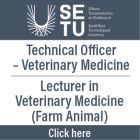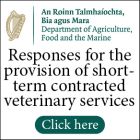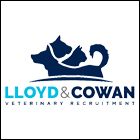Large animal - December 2018
The role of the veterinarian in European farming of the future
Dramatic changes are predicted for European agriculture by 2050, and beyond. This month, Veterinary Ireland Journal’s large-animal editor, Frank O’Sullivan MVB MSc (Food Science) MRCVS, considers opportunities that are available for veterinarians and the ways the veterinary profession must evolve to be relevant
Climate change
There are multiple and very diverse challenges ahead, with good evidence that these challenges are increasing (in intensity, in complexity and in frequency) given increasing global consecutiveness and cumulative global damage.
Global warming presents an immediate cascading risk to food security and nutrition. A range of physical, biological and biophysical changes will influence agri-ecosystems translating into impacts on agricultural production. Reducing the extent of future climate change, by limiting the amount of greenhouse gases (GHG) being emitted, and by increasing the rate of removal of carbon dioxide (CO2) from the atmosphere, is a significant global challenge. The agriculture sector (with veterinary involvement), forestry and other land-use sectors are responsible for 24% of the global emissions. Thus, to reduce the impacts on climate change there is a clear need to develop robust mitigation strategies that can lower emissions and deliver a low-carbon future. Furthermore, these mitigation measures can be sub-divided into three categories:
- Agricultural mitigation: Measures with reduced agricultural GHG (ie. directly reduce methane and nitrous oxide);
- Land-use mitigation: Measures that enhance CO2 removal from the atmosphere in terms of land management or land-use change in forestry (LUCF) and;
- Energy mitigation: reductions from displacement of fossil fuels via energy saving, enhanced cultivation of biomass and/or adoption of anaerobic digestion.
The veterinarian has a key role in reduction of GHG emissions through enhancement of herd health efficiency. ‘producing more from less’ by improving fertility parameters, with increased efficiency of young stock reared for beef, pig and poultry production. Veterinary involvement in nutrition and breeding advice is critical. The veterinary profession needs to be a leader in considering the moral and ethical questions for intergenerational justice and in questioning the type of planet we leave for the generations ahead.
Population increase and changing demands
World population is expected to reach 9.1 billion by 2050. Nearly all this growth is forecast to take place in developing countries. Farmers worldwide will have to increase food production by 70% to meet these demands, according to the Food and Agricultural Organization (FAO).
Rapidly growing Asian economies are expected to account for the greatest share of additional consumption with their ever-increasing middle classes. The demand for meat, fish and dairy protein products will increase substantially through the next decade, because of higher income levels and increasing urbanisation in developing regions. Global meat consumption is projected to increase by 1.6% per annum through the next decade, resulting in more than 58 metric tonnes (MT) of additional meat consumed by 2023.
Demand for dairy products will also continue to expand at a rapid rate through the next decade. Per capita, consumption of dairy products in developing countries is expected to increase by 1.2% to 1.9% per annum, with the expansion in demand reflecting robust income growth and further globalisation. These changing consumer tastes and preferences in developed markets will, however, lead to significantly higher growth rates in the consumption of food that meets specific requirements (eg. sustainably produced, more natural characteristics, free-from labelling, etc). Currently, there is increasing consumer anxiety over the lack of integrity around some farm and food products in terms of welfare, food miles, use of antibiotics and GHG emissions. The veterinary profession understands the complexity of the food chain and how farm events impact the food subsequently consumed. The veterinary profession is well-positioned to design and deliver measurable welfare, animal health and food safe parameters that will be in demand.
Protecting the integrity of the food chain
Most biological zoonoses begin on farm. In addition, there are increased opportunities for chemical and physical hazards to enter the complex food chain. In Ireland, we have learned these lessons the hard way. For example, in 2008 the veterinary profession contributed significantly to the risk assessment when dioxins were discovered in Irish pork. An immediate, European-wide food recall of all Irish pork products allowed for prompt removal of a potential carcinogenic threat. Inappropriate, ‘non-food grade’ waste oil that was used to heat pig meal prior to feeding was identified as the source. The integrity of our pig industry was maintained by rapid action, with clear risk management and risk communication by a multidisciplinary team, including the veterinary profession. Regardless of what part of the food chain the vet participates in, we understand the epidemiological relationships of farm events and the food chain. For instance, in Ireland, vets and farmers support a ‘clean cattle and sheep policy’ so that we can reduce E. Coli 0157 in foods distributed across Europe and the world. As a profession, we are well-positioned to make significant contributions in risk assessments for food safety, animal welfare, animal health and sustainability. We also make these veterinary contributions via many channels in Europe, including the European Food Safety Authority (EFSA), established by the EU to be a source of scientific advice and communication on the risks associated with the food chain. There is a need for vets to be involved to a greater degree in risk analysis, risk management and, indeed, risk communication. This is not only necessary for prevention of food safety risks but also to protect the reputational integrity of the food industry.
At farm level, the veterinarian will use their epidemiological skills to interpret increasingly complex but very useful data from the larger herds and flocks across Europe. Dairy cows and beef animals will carry devices that monitor clinical, mobility, behavioural and metabolic parameters in order to inform management decisions.
Technology will play a huge role post-farm gate, for example with genetic fingerprinting and other novel technologies, we will be able to trace a salmonella outbreak in China to the farm of origin in Ireland; or track the introduction of an antibiotic-resistant strain of bacteria in the food chain through animal or people movements across the globe. The veterinarian has an opportunity to be a key driver of outcome-based, independently-verified, standards that are transparent across the entire food chain.
European legislation
The vet can be a leader in governance and contribute more positively to society through an understanding and application of veterinary science. The future development of farming in Europe will very much depend on EU policy and the international competitiveness of European agriculture alongside the willingness of the EU tax-payer to fund some uncompetitive farmer sectors for the benefit of food security, food safety, animal welfare and the environment. The veterinarian’s role will be more and more as a component of a service-delivery sector to the internationally competitive trading agricultural sector. This service will be increasingly delivered through multi-services channels, delivering goods and services, including advice, knowledge and plans (herd health and welfare plans, food-safety management plans, grass-management plans, nutritional plans, IT, business, etc.) to customers. Clinical cases on farms will act like sentinels, informing what are the major subclinical issues going on at farm level. Furthermore, the farm veterinarian will be a key part of the animal-health surveillance for notifiable diseases, such as foot and mouth disease, African swine fever, etc. During the 1991 foot and mouth outbreak in Ireland, we learned the value of early veterinary disease detection and the subsequent saving of huge costs to the country. Veterinarians will lead and participate in the multi-disciplinary teams delivering these services, both on farm and in the food industry. In Victoria State in Australia, veterinary practices have already developed scale and expertise and, therefore, can deliver a multitude of services, including business courses, industrial relations and general training for different sectors of the local rural economy. Regarding the protected agri-sector, the veterinary role will evolve depending on the level of EU support in the different pillars of the Common Agricultural Policy (CAP). Veterinary practices will likely deliver knowledge transfer on farm and to small businesses supported by rural development grants.
In the EU, the opinion and advice of the Federation of Veterinarians of Europe (FVE) will be regularly in demand. FVE delegates from many EU counties are trusted to give impartial, sound veterinary input to facilitate prudent legislative change. At country level, veterinary organisations such as Veterinary Ireland will be very important stakeholders that will represent the veterinary sector's view of EU rural development policy. In the area of food safety, meat inspection will be modernised. The role of the vet in public health is another immense area in terms of safeguarding the future of farming in Europe, and in maintaining standards in the supply chain from farm to fork. The role of the vet in public health is defined as ‘the application of veterinary science to protect and improve the physical, mental and social wellbeing of humans’. This has implications in terms of preventing zoonotic disease and safeguarding animal welfare, as well as in understanding antimicrobial resistance (AMR) and safeguarding the environment.
Communication is key
The veterinary profession is evolving with time and this is best-illustrated by the changing manner of communication within the sector. Good communication skills are valuable in all aspects of veterinary medicine. The benefits of enhanced communication skills will lead to more effective consultations for clients, veterinarians and patients. In addition, veterinarians have not always been team players at organisational and government level. Historically, the veterinarian may have adopted a top-down method of communication, emphasising the vet’s hierarchy in the transfer of information, the ‘do what I tell you’ approach. Farm veterinarians have found it difficult to translate best science and technical advice into action on the farm. Farmers do not always make decisions based on rational technical and economic considerations. Understanding and developing new communication skills towards positive-behaviour change on-farms is necessary to make disease prevention a reality.
The vet of the future will need to be an ‘information clarifier’, not necessarily an information provider (the internet does this very well!). The ability to regurgitate veterinary technical knowledge is no longer enough to be credible in the veterinary practice of the future. Good communication will be a prerequisite to the survival of the vet’s involvement in the farm and agri-industry. The veterinarian will no longer work in a ‘silo’ but will be able to work and communicate with multiple advisors. Communication serves as the foundation of every facet of business. Engaging in a more multidisciplinary approach in the future would enable vets to use their wide range of disciplines to good effect. Key communication skills, such as asking open questions, using affirmations, and listening reflectively will be of value. The concept of ‘feedforward’ (positive and enabling) versus ‘feedback’ (negative and critical) is very useful to the veterinary practitioner. Feedforward provides information about what one could do better in the future, often in contrast to what one has done poorly in the past. Feedforward focuses on creating positive emotions and attitudes.
Vertical integration of communication skills in veterinary undergraduate programmes is becoming the norm. It allows for repeated exposure and practice of communication by the students and, uses scaffolding to build their skills as they encounter more complex situations. The deliberate integration of communication skills into many (clinical and non-clinical) teaching units means they are considered integral to practising all aspects of veterinary medicine – not just a ‘soft skill’ to be taught as an adjunct to ‘real veterinary medicine’.
Summary
There will be an increasing need for robust veterinary expertise in support of animal health and welfare; food safety and sustainability at all levels – from farm to the consumers across the world. Consider the skills base that veterinarians can provide:
At farm-level
- Independent advice and education in support of decision-making with clinical and sub-clinical risk management as part of vertically-managed herd-health teams.
- Problem-solving at farm level.
- A team player as part of a multidisciplinary team
Independent accreditation, ie. validation of claims at farm and processor level.
At country/EU level:
- Contribution to problem-solving. The skills of veterinarians are unique in understanding the bigger picture in a multidisciplinary approach at country and EU level.
European farming and food will face considerable complex challenges in the future. Veterinary expertise in animal health, welfare, food safety and sustainability, together with the veterinarian’s skills in risk analysis will be very relevant and in demand. Our challenge is to be excellent communicators in multidisciplinary teams and help navigate European food and farming through future rough seas. The success of the veterinary profession will depend on whether it can unlock its potential.
Acknowledgements
Many thanks to the following for their contribution: Sean O Laoide; Professor Simon More; Catherine Carty; Eoin Ryan; Charles Chavasse; Bernadette Earley; Conor McAloon; and Fergal Morris.










